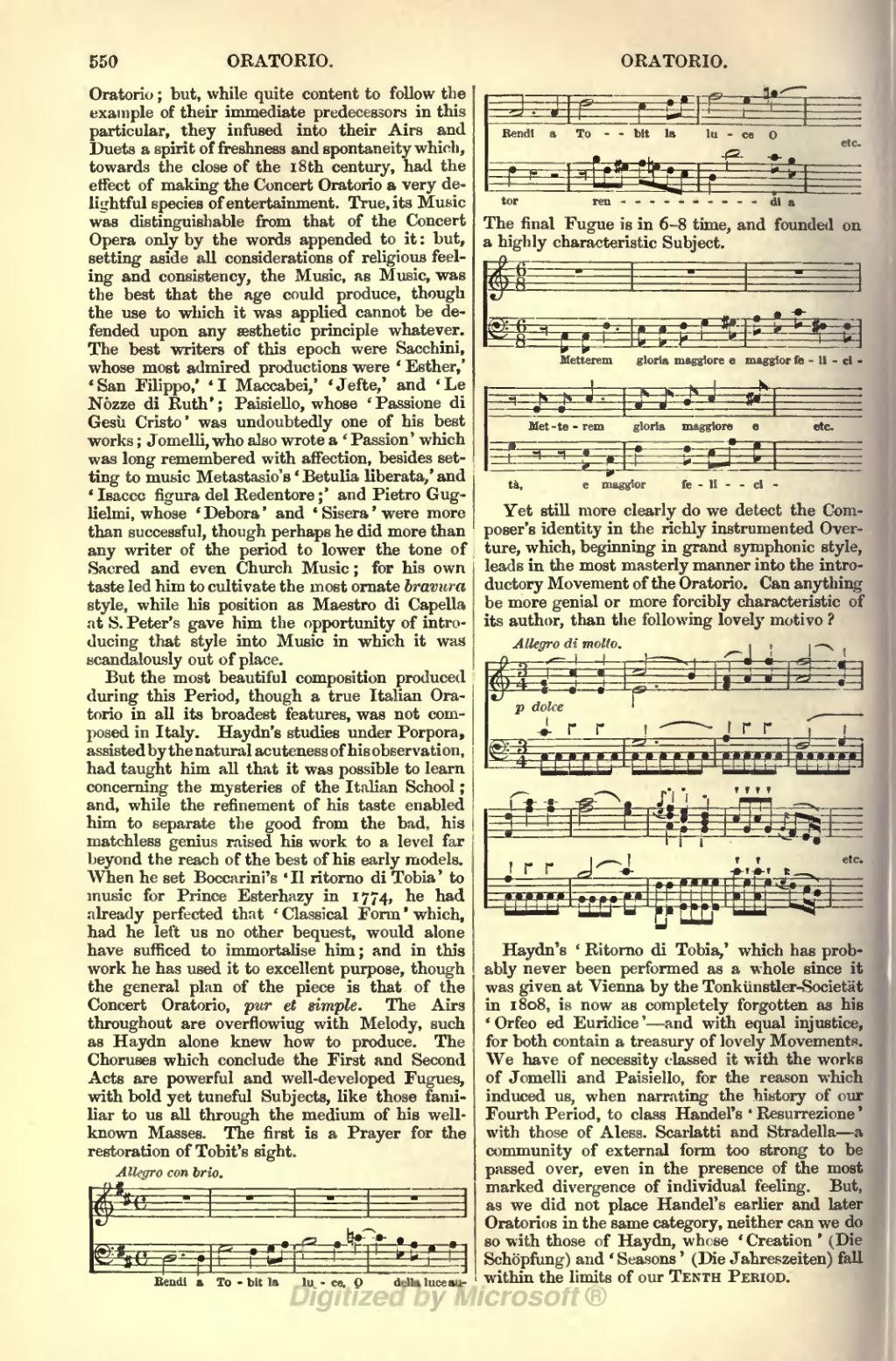Oratorio; but, while quite content to follow the example of their immediate predecessors in this particular, they infused into their Airs and Duets a spirit of freshness and spontaneity which, towards the close of the 18th century, had the effect of making the Concert Oratorio a very delightful species of entertainment. True, its Music was distinguishable from that of the Concert Opera only by the words appended to it: but, setting aside all considerations of religious feeling and consistency, the Music, as Music, was the best that the age could produce, though the use to which it was applied cannot be defended upon any æsthetic principle whatever. The best writers of this epoch were Sacchini, whose most admired productions were 'Esther,' 'San Filippo,' 'I Maccabei,' 'Jefte,' and 'Le Nozze di Ruth'; Paisiello, whose 'Passione di Gesù Cristo' was undoubtedly one of his best works; Jomelli, who also wrote a 'Passion' which was long remembered with affection, besides setting to music Metastasio's 'Betulia liberata,' and 'Isacco figura del Redentore;' and Pietro Guglielmi, whose 'Debora' and 'Sisera' were more than successful, though perhaps he did more than any writer of the period to lower the tone of Sacred and even Church Music; for his own taste led him to cultivate the most ornate bravura style, while his position as Maestro di Capella at S. Peter's gave him the opportunity of introducing that style into Music in which it was scandalously out of place.
But the most beautiful composition produced during this Period, though a true Italian Oratorio in all its broadest features, was not composed in Italy. Haydn's studies under Porpora, assisted by the natural acuteness of his observation, had taught him all that it was possible to learn concerning the mysteries of the Italian School; and, while the refinement of his taste enabled him to separate the good from the bad, his matchless genius raised his work to a level far beyond the reach of the best of his early models. When he set Boccarini's 'Il ritorno di Tobia' to music for Prince Esterhazy in 1774, he had already perfected that 'Classical Form' which, had he left us no other bequest, would alone have sufficed to immortalise him; and in this work he has used it to excellent purpose, though the general plan of the piece is that of the Concert Oratorio, pur et simple. The Airs throughout are overflowing with Melody, such as Haydn alone knew how to produce. The Choruses which conclude the First and Second Acts are powerful and well-developed Fugues, with bold yet tuneful Subjects, like those familiar to us all through the medium of his well-known Masses. The first is a Prayer for the restoration of Tobit's sight.
![<< \override Score.Rest #'style = #'classical \new Staff { \time 4/4 \key d \major \tempo \markup { \italic "Allegro con brio." } \relative a' { R1*4 a2. a4 | d2 cis4 d8 e | fis2 e4 g ~ | s_"etc." } }
\addlyrics { Rendi a To -- bit la lu -- ce O }
\new Staff { \clef bass \key d \major \relative d { \autoBeamOff d2. d4 | g2 fis4 g8[ a] | b2 a4 c ~ | c b8 a g4 a | fis4 r4 r2 | r8 b[ fis gis] a[ g fis e] | d4 d'2 cis8 b | s4 } }
\addlyrics { Rendi a To -- bit la lu -- ce, O del -- la luce au -- to ren -- _ _ _ di a } >>](http://upload.wikimedia.org/score/d/b/dbxa0fi3f3qrrdwe6dmregtneum02ro/dbxa0fi3.png)
The final Fugue is in 6-8 time, and founded on a highly characteristic Subject.
![<< \new Staff { \time 6/8 \relative g' { \autoBeamOff R2.*3 r8 g g c4. | a8 a b c4 cis8 | s_"etc." } }
\addlyrics { Met -- te -- rem glo -- ria mag -- giore e }
\new Staff { \clef bass \relative c { \autoBeamOff r8 c c f4. | e8 e f g4 gis8 | a b c fis,4 fis8 g4 r8 r e c | f4 f8 e[ a] g | s } }
\addlyrics { Met -- te -- rem glo -- ria mag -- giore e mag -- gior fe -- li -- ci -- tà, e mag -- gior fe -- li -- ci -- } >>](http://upload.wikimedia.org/score/j/d/jd9189axuicuc9g1rg69gsp4z3ax0uw/jd9189ax.png)
Yet still more clearly do we detect the Composer's identity in the richly instrumented Overture, which, beginning in grand symphonic style, leads in the most masterly manner into the introductory Movement of the Oratorio. Can anything be more genial or more forcibly characteristic of its author, than the following lovely motivo?

Haydn's 'Ritorno di Tobia,' which has probably never been performed as a whole since it was given at Vienna by the Tonkünstler-Societat in 1808, is now as completely forgotten as his 'Orfeo ed Euridice'—and with equal injustice, for both contain a treasury of lovely Movements. We have of necessity classed it with the works of Jomelli and Paisiello, for the reason which induced us, when narrating the history of our Fourth Period, to class Handel's 'Resurrezione' with those of Aless. Scarlatti and Stradella—a community of external form too strong to be passed over, even in the presence of the most marked divergence of individual feeling. But, as we did not place Handel's earlier and later Oratorios in the same category, neither can we do so with those of Haydn, whose 'Creation' (Die Schöpfung) and 'Seasons' (Die Jahreszeiten) fall within the limits of our Tenth Period.

